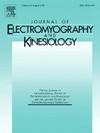Optimizing passive exoskeleton torque for dynamic overhead work: Phase-specific analysis on muscle activity and perceived exertion
IF 2.3
4区 医学
Q3 NEUROSCIENCES
引用次数: 0
Abstract
Purpose: This study investigated how different levels of torque provided by a passive arm-support exoskeleton (ASE) influence upper extremity muscle activity, perceived exertion, and fatigue during arm ascent and descent phases of a Dynamic Overhead (DO) task. Methods: The DO task involved 20 cycles of simulated drilling and was completed by 20 individuals by using a light-duty drill in four conditions: without supporting torque (no ASE) and with three increasing levels of ASE torque (i.e., 50, 75, and 100% of the torque required to support the arm in 90° of flexion). Surface electromyography was measured bilaterally over six shoulder muscles. Moreover, participants indicated torque preference, ratings of perceived exertion (RPE), and fatigue in the shoulder. Results: Increasing torque levels caused significant reductions in shoulder agonist muscle activity (up to 47%) and significant decreases in RPE and fatigue during the ascent phase. In contrast, higher levels of torque increased muscular activity for some antagonist muscles during the descent phase. Conclusions: While torque levels of 75% and 100% received the most positive ratings, we suggest that 75% torque could be an effective supporting condition, by reducing shoulder muscle flexor activity during arm ascent and minimizing antagonist muscle activity during arm descent.
优化被动外骨骼扭矩动态顶工作:肌肉活动和感知消耗的阶段特定分析
目的:本研究调查了被动臂支撑外骨骼(ASE)提供的不同水平的扭矩如何影响动态架空(DO)任务中上肢肌肉活动、感知劳累和上肢疲劳。方法:DO任务包括20个模拟钻孔循环,由20个人使用轻型钻头在四种条件下完成:无支撑扭矩(无ASE)和三种增加的ASE扭矩(即支持手臂90°弯曲所需的扭矩的50%,75%和100%)。测量两侧六块肩部肌肉的表面肌电图。此外,参与者还指出了扭矩偏好、感知用力等级(RPE)和肩部疲劳。结果:增加扭矩水平导致肩激动剂肌肉活动显著减少(高达47%),在上升阶段RPE和疲劳显著减少。相反,在下降阶段,较高的扭矩水平增加了一些拮抗肌的肌肉活动。结论:虽然75%和100%的扭矩水平得到了最积极的评价,但我们认为75%的扭矩可以是一个有效的支持条件,通过减少手臂上升过程中肩部肌肉屈肌的活动,并减少手臂下降过程中拮抗剂肌肉的活动。
本文章由计算机程序翻译,如有差异,请以英文原文为准。
求助全文
约1分钟内获得全文
求助全文
来源期刊
CiteScore
4.70
自引率
8.00%
发文量
70
审稿时长
74 days
期刊介绍:
Journal of Electromyography & Kinesiology is the primary source for outstanding original articles on the study of human movement from muscle contraction via its motor units and sensory system to integrated motion through mechanical and electrical detection techniques.
As the official publication of the International Society of Electrophysiology and Kinesiology, the journal is dedicated to publishing the best work in all areas of electromyography and kinesiology, including: control of movement, muscle fatigue, muscle and nerve properties, joint biomechanics and electrical stimulation. Applications in rehabilitation, sports & exercise, motion analysis, ergonomics, alternative & complimentary medicine, measures of human performance and technical articles on electromyographic signal processing are welcome.

 求助内容:
求助内容: 应助结果提醒方式:
应助结果提醒方式:


